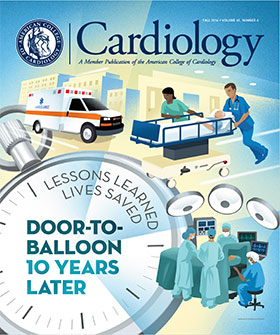Cardiovascular Innovation: Moving Cardiovascular Care Forward Summit
Emerging technologies such as digital health tools, big data analytics and precision medicine have the potential to transform health care. Yet, in practical terms, what does this really mean and how do we get there? And, how do we integrate these potential innovations as seamlessly and intuitively into the clinical care delivery, while ensuring we provide solutions for the real needs of clinicians and patients?
The ACC held its first-ever Cardiovascular Innovation Summit: Moving Cardiovascular Care Forward at Heart House in September, signaling the College’s deepening commitment to shaping innovation in cardiovascular medicine. The one-day think tank was co-chaired by ACC’s Chief Innovation Officer John S. Rumsfeld, MD, PhD, FACC, and Harlan M. Krumholz, MD, SM, FACC, a well-known change leader and professor of medicine and epidemiology at Yale School of Medicine.
The multidisciplinary group of participants was charged with identifying the principles for meaningful transformation of health care to improve cardiovascular care and health outcomes. In-depth discussions were facilitated on emerging technologies to support innovation, accelerating innovation and principles for evaluation, and the integration of innovation in care delivery. “Each table, each session, each report out began with a patient engagement, patient-centric objective, or a shared decision-making focus,” noted Leslie Kelly Hall, vice president of policy at Healthwise.
“What can be done to bridge the gap between what is possible and what is happening, and how do we get to a better future faster?” asked Krumholz. These key questions helped to frame the discussion and the objective for the think tank. In defining the road forward, Rumsfeld stressed that the focus must be improving health, not health care, which he noted aligns with the mission of the ACC: to transform cardiovascular care and improve heart health.
Participants recommended that the ACC use its robust infrastructure, networks, resources and voice to explore the specific needs that innovation can address and engage experts required for successful collaborations. The expertise of the College in implementation science and its vast data from the NCDR are invaluable resources for this effort.
Prospectively defining the problems for which to seek innovative digital or technological solutions emerged as a guiding tenet from the discussions. Aside from the development of some devices, much of the digital tools and solutions have been created by tech companies with their outsider perspective, often meaning they are retrofitted into workflow or may miss the mark for a tool that could truly benefit care and outcomes. The solutions must be customized to meet the needs of clinicians and patients.
Electronic health record (EHR) technology is a prime example of an innovation where frustration and challenges overshadow its great potential. Let’s ask ourselves, suggested Krumholz, why Google does not require us to spell correctly to access its knowledge resources and have a successful user experience, but this same experience is not found when using an EHR. Such thinking and questioning will be needed to unleash the potential for innovation that will improve quality of care, improve patient outcomes through targeted care and therapeutics, and reduce variation in care and waste.
The Summit served as a catalyst for ongoing collaboration across health care stakeholders who share a commitment to accelerate meaningful health care transformation. One specific next step is the development of a Roadmap for Innovation in Cardiovascular Care document, informed by the presentations and discussions at the Summit.

|
|
|
|
Keywords: Cardiology Magazine, ACC Publications, Cooperative Behavior, Decision Making, Electronic Health Records, Patient Participation, Workflow
< Back to Listings

 The ACC was a sponsor of Georgetown University’s intercollegiate hackathon, called Hoya Hacks, which took place Nov. 4 – 6 in Washington, DC. During the 36-hour event, 350 participants worked tirelessly to build innovative software and hardware solutions in response to a list of challenges posed by organizations such as the ACC. The hackathon challenged participants to develop solutions related to improving patient-clinician communication, tracking health status, improving medication adherence and streamlining care coordination among patients, families, clinicians and health systems.
The ACC was a sponsor of Georgetown University’s intercollegiate hackathon, called Hoya Hacks, which took place Nov. 4 – 6 in Washington, DC. During the 36-hour event, 350 participants worked tirelessly to build innovative software and hardware solutions in response to a list of challenges posed by organizations such as the ACC. The hackathon challenged participants to develop solutions related to improving patient-clinician communication, tracking health status, improving medication adherence and streamlining care coordination among patients, families, clinicians and health systems.

